Key Takeaways: Tour of Flanders 2025
Breaking down exactly how Tadej Pogačar dismantled the sport’s top one-day riders on Sunday en route to a stunning victory—one that puts him on track to surpass the sport's all-time greats
On Sunday, across the sunny, green Flemish landscape, Tadej Pogačar claimed his second Tour of Flanders title in just his third appearance at the race, launching an unstoppable solo attack on the Oude Kwaremont and leaving behind one of the more high-powered chase groups in the recent memory of the race. Despite the presence of heavyweights like Mathieu van der Poel and Mads Pedersen—who finished second and third respectively—Pogačar was on a completely different level, riding with the kind of dominance that has many wondering if we’re witnessing the early chapters of the greatest career in cycling history.
Check out the defining points of the race, and my five key takeaways (expand from my initial post-race Flanders thoughts) below:
Tour of Flanders 2025 Top Ten
1) Tadej Pogačar (UAE Team Emirates-XRG) +0
2) Mads Pedersen (Lidl-Trek) +1’01
3) Mathieu van der Poel (Alpecin-Deceuninck) +1’01
4) Wout van Aert (Visma-Lease a Bike) +1’01
5) Jasper Stuyven (Lidl-Trek) +1’04
6) Tiesj Benoot (Visma-Lease a Bike) +1’51
7) Stefan Küng (Groupama-FDJ) +1’53
8) Filippo Ganna (INEOS Grenadiers) +2’19
9) Iván García Cortina (Movistar Team) +2’19
10) Davide Ballerini (XDS Astana) +2’19
BTP’s Spring Classics Coverage is brought to you by JOIN Cycling
The JOIN Cycling App is a smart training platform that adapts to your schedule, goals, and fitness level, offering dynamic, science-backed workouts. It’s perfect for cyclists of all levels, balancing training and recovery efficiently. With AI-driven adjustments and flexibility, JOIN helps you stay motivated and improve consistently. Redeem a free month through our special BTP link.
Race Notebook
BTP is seamlessly following every twist and turn of the 2025 Classics Season with the fantastic Tour Tracker app (iPhone/Android/Web)
108km-to-go: After an early crash brought down Mathieu van der Poel, forcing his Alpecin team to fully focus on pacing him back into the bunch and brought down multiple of Tadej Pogačar’s UAE teammates, the race gets slightly chaotic, with Visma’s Tiesj Benoot getting into a strong move chasing up to the breakaway, and riders like Filippo Ganna sneaking up the road to join them.
95km: This creates a situation where Pogačar crash-depleted UAE team has to get to the front and set a hard pace to hold the gap as close as possible (currently at 50 seconds), all while the teams with riders up the road, like Visma, who still has nearly a full team remaining, Ineos and Alpecin, sit on.
56km: On the approach of the second (and penultimate) pass of the Oude Kwaremont, Pogačar, with almost no team support remaining, is buried in the field with Van der Poel and in a position where he cannot launch an attack (which he needs to do if he wants to drop his larger-framed rivals). Meanwhile, Visma’s top riders are all present at the front.
56km cont: However, Pogačar turns the tables over the course of just a few moments, with his last remaining teammate Florian Vermeersch attacking, in an attempt to get ahead of the incoming attack so he can give Pogačar a few pulls near the top of the climb; Pogačar slips through a gap near the side of the road and hits the front while Van der Poel is stuck in the bunch behind.
56km cont: As soon as he hits the front, Pogačar opens a gap on the peloton (and blows by his teammate Vermeersch), with the well-positioned Van Aert the only one able to hold his wheel.
55km: Slightly further up the climb, Pogačar is still pressing the pace on the front, with the Visma duo of Jorgenson/Van Aert on his wheel, Lidl-Trek’s Mads Pedersen closing the gap behind, and Van der Poel putting in a huge effort to get on terms before the top of the climb. Considering Pogačar’s time up the climb sets the Strava KOM, this effort must have cost Van der Poel dearly.
51km: Despite this massive effort, on the next climb, the Paterberg, Van der Poel is on the front pressing the pace, with Pogačar on his wheel (even blowing by his teammate Quinten Hermans, who was in the breakaway). Considering the onus is on Pogačar to drop Van der Poel, and the chasing set of teammates will have plenty of motivation to ride behind, this decision, which leaves Van der Poel vulnerable, is baffling.
49km: And, once over the climb, Van der Poel keeps riding to hold off the chasing peloton behind, but, again, Pogačar, who is without teammates, is allowed to sit on and recover before hitting more climbs, where he must attack his faster rivals.
45km: And, as soon as they hit the uber-steep Koppenberg, Pogačar attacks while the others put in massive efforts to hold his wheel and/or chase back on over the top after being dropped.
41km: After the group comes back together, Pedersen and Van Aert attack, likely thinking they need to get ahead of the next Pogačar attack. Instead of using this opportunity to force Pogačar to work, Van der Poel gets to the front and closes down the move, allowing Pogačar to yet again rest prior to the next climb.
40 km- 27 km: On the following series of climbs, Pogačar goes to work, pressing the pace at every opportunity, which is slowly chipping away at their legs and setting up a bigger attack on the harder Kwaremont, which is now make or break for Pogačar.
18km: And, once they hit the Kwaremont, Pogačar rides clear after he yet again lifts the pace, and the longer nature of the climb magnifies his superior climbing ability. Behind, Van der Poel, who at first attempted to hold the wheel, falls back to the Van Aert, Pedersen, Stuyven chase group.
14km: By the time they reach the final climb, the last pass of the Paterberg, just four kilometers later, Pogačar’s lead is out to 28 seconds, which is stunning considering the chase group contains two Lidl-Trek riders (Stuyven and Pedersen), and Van Aert and Van der Poel, who are willing to go all-in for the win instead of podium placings.
Finish: Pogačar is so strong over the final flat 12 kilometers that when he crosses the finish line to grab his second career Flanders win, in just three starts, his lead is out to a minute. Behind, it is made clear that Van der Poel and Van Aert weren’t bluffing during the chase when Mads Pedersen sprints clear for second place, and Van der Poel barely holds off his old rival for third place in a slow-speed sprint.
Five Key Takeaways
The first three takeaways are a slightly edited version of my initial post-race thoughts sent to premium subscribers directly after the race on Sunday
1) Tadej Pogačar’s All-In Strategy Paid Off: Despite the pressure being on him to distance the heavier Classics specialists, like Mathieu van der Poel, before the finale, everyone knowing it was coming, and being isolated from his team, Pogačar pressed clear on the Oude Kwaremont, the only climb on the course hard enough to allow him to leverage his superior climbing ability before riding clear of a four-rider group to take his second career Flanders title.
After his UAE team was thinned down by crashes and early pacesetting, Pogačar found himself outnumbered and seemingly outflanked heading into the final circuit of the race. For a moment, if one squinted hard enough, Pogačar looked in trouble and with increasing pressure to drop the world’s strongest Classics riders on the single climb where they might not struggle to follow.
However, over the course of just a few kilometers, Pogačar closed the gaps and reshaped the race before launching a thermonuclear attack on the Kwaremont that put everyone else on the back foot, put distance between himself and the others, and left Van der Poel, who appeared unshakable on the series of climbs beforehand, stranded in a chase group behind.
And, even after this impressive climbing performance, Pogačar still had four of the strongest riders in the world just a few seconds back, but he continued to pile on the pressure, gradually increasing his lead over the chase group all the way to the finish line.
One of the things that makes this even more impressive is Pogačar's relatively lightweight. At roughly 65 kilograms, Pogačar is roughly 13-20 kilograms (25- 40lbs) lighter than the rest of the front group, which makes it astonishing that he was able to ride clear of these ultra-powerful riders on terrain that should theoretically suit them better.
For example, the disadvantage is so extreme that on a climb like the Kwaremont, Pogačar would have had to put out .4 watts per kilogram more than a rider of Van der Poel’s weight just to match the pace, and .6 watts/kg more to drop him in the way he did.
To accomplish this, Pogačar took the race to his rivals as early as possible, having his team press the pace from well over 100 kilometers out, and attacking nearly every climb personally when he lost his last teammate with over 55 kilometers left to race.
This pace-pressing not only produced the fastest-ever edition of the race (45km/hr), but it also created a race situation where only Pogačar could win, as it fatigued the others to the point where they couldn’t follow the Slovenian on the climbs, or had enough to reel him in once over the top.
But it also carried serious risks since it meant he was isolated for massive portions of the key sections, and it almost ensured that he had to launch a winning solo move in order to win.
2) Pogačar Is Quickly Closing In, if Not Already Surpassing, the All-Time Greats: This performance means that at just 26 years old, Pogačar is well on his way to being considered the best rider in the sport’s history.
Just four years after he won his first career Monument at the 2021 edition of Liège–Bastogne–Liège, Pogačar already has eight career Monument wins, which slots him into 6th of all-time, and actually ahead of Eddy Merckx’s pace at the same point in his career (Merckx would go onto win 19 Monuments, so Pogačar has to keep this pace up for at least five more seasons to match him).
After Van der Poel pulled even with Pogačar a few weeks ago at Milan-Sanremo, Pogačar once again tips the Monument scales in his favor, with an eight-to-seven lead over his rival (who is four years older), and evens the score in 2025, with each rider having a Monument win each.
Not only did Pogačar notch up another win over his biggest one-day rival with today’s performance, but he also overtook him for the best run of results in a rider’s first three Flanders starts in history.
While Van der Poel, who has the best record of any rider in the event’s history through their first seven starts, racked up two podiums and a win through 2019-2021, Pogačar has surpassed this with two wins and three top fives through just three starts.
These tallies are all certainly formidable, but perhaps the most impressive part is that Pogačar is doing this in his spare time in between winning Tours de France, a feat that is almost always all-consuming for whoever is attempting it.
The fact that only a handful of riders have even attempted to win both the biggest one-day races and Grand Tours in the same season, and the ones that did, like Bernard Hinault, were competing in a much less professionalized peloton, means that a strong case could already be made for Pogačar to already be considered the best rider of all-time.
3) Modern Racing Leaves Few Chances for the Rest: While Pogačar charged to victory with apparent ease, the riders behind appeared to be struggling in his wake. But, in this case, perception wasn’t reality, since multiple riders in the chase group, like Mads Pedersen, Van der Poel, and Jasper Stuyven, put in career performances to finish in the top five. The fact that they did so, and were still left fighting for the podium, shows just how dominant Pogačar is, and how much he has changed racing, both specifically at Flanders and across the entire one-day calendar.
For example, in the recent past, it would have been considered impossible for a Tour de France contender to drop in and not just challenge, but dominate, powerful riders like Van Aert, Van der Poel, and Pedersen, on their own turf.
One of the main reasons Pogačar is able to do this is the shift to solo winners and the fact that sprint finishes have been almost completely eliminated in one-day racing.
In the last 21 major one-day races (Monuments, Olympics, and World Championships), a solo rider has won 17 times.
This means top-end finishing speed, often generated by raw power and size, isn’t nearly as important. Instead, what matters the most is the ability to make the race as hard as possible to set up an attack before pressing your advantage with a knockout blow.
Illustrating just how selective this has made the top races, these 21 races have been won by just six different riders (Jasper Philipsen, Dylan van Baarle, Matej Mohorič, Mathieu van der Poel, Remco Evenepoel, and Pogačar), with only three of these riders, Evenepoel, Van der Poel and Pogačar, taking all the solo wins in the last 2.5 years.
In addition to equipment changes like wider tires with lower pressures, which potentially gives lighter riders a smooth ride over the cobblestones, reducing the traditional advantage held by heavier, more powerful riders, a major cause for this shift is the transition to line-to-line all-out racing, enabled by powerhouse teams that make the racing relentless from start to finish, which makes the racing so difficult and selective that only the strongest rider with the best watts per kilogram ratio can contend for the victory.
While the two flatter one-day races, Milan-Sanremo and Paris-Roubaix, have remained beyond Pogačar’s reach so far, his apparent continual improvement means that he could expand his already long reach when he takes the start line next week for his first attempt over the absurdly rough cobblestones at Roubaix.
4) Pogačar Has the Rare Ability to Punish Mathieu van Der Poel’s Tactical Misfires: The 30-year-old, who, with three wins and six podiums in his first seven starts at this race, is without question one of the most potent Tour of Flanders competitors ever, was toppled by the only other rider in the history of the event to have a stronger first three starts. While the crash early in the race, and the subsequent chase, certainly didn’t help, it was hard not to feel like we watched Pogačar elevate his one-day game to a level above Van der Poel, both physically and tactically, on Sunday.
For example, when Van der Poel was in the elite front group after the second pass of the Kwaremont, the pressure should have been on Pogačar to make the race hard enough to drop Van der Poel, who would have been the favorite in a sprint.
With no teammates in the group, it wasn’t obvious how Pogačar was going to hold the group, which contained two sets of teammates, together, all while making it hard enough to drop every other rider in the group.
This was no small feat, and Pogačar could have found himself in a tricky position, but, lucky for him, Van der Poel decided to take a large chunk of responsibility for closing gaps and pressing the pace on late climbs, which ultimately set up the winning Pogačar move.
Of course, things could look a lot different next week at Roubaix, which, at least in theory, will suit Van der Poel more than Pogačar, but it is likely that the final 55 kilometers of Flanders, where Pogačar always appeared to be on the front foot and in the right place, while Van der Poel was forced to react, will have Pogačar feeling far more confident than Van der Poel heading into the clash.
5) The Best of the Rest Finally Appear Able to Threaten the One-Day Duopoly: One thing that could be lost in Pogačar’s spectacular win on Sunday is just how much higher of a level the race was operating at compared to last year, which saw Van der Poel ride clear at roughly 50 kilometers remaining with almost no resistance.
Instead, a rejuvenated Visma team, which featured a strong Jorgenson and a Van Aert who appears to be working back into top form (his Kwaremont time was the fastest of his career), and Lidl-Trek, who sported versions of Pedersen and Stuyven that appear to be in the best form of their careers, provided worthy foils to the two stars that have been dominating the sport’s top one-day races.
This trend of the form and health of the top stars aligning bodes extremely well for the level of competition in top one-day races in the near future, and, especially when we consider how aggressive and inventive teams like Visma and Ineos were willing to be on Sunday, tells us that they will eventually find a calculus that allows them to catch out the one-day duopoly of Van der Poel and Pogačar.

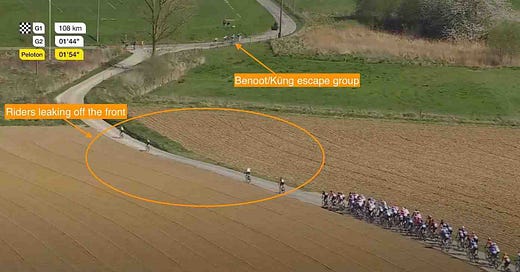






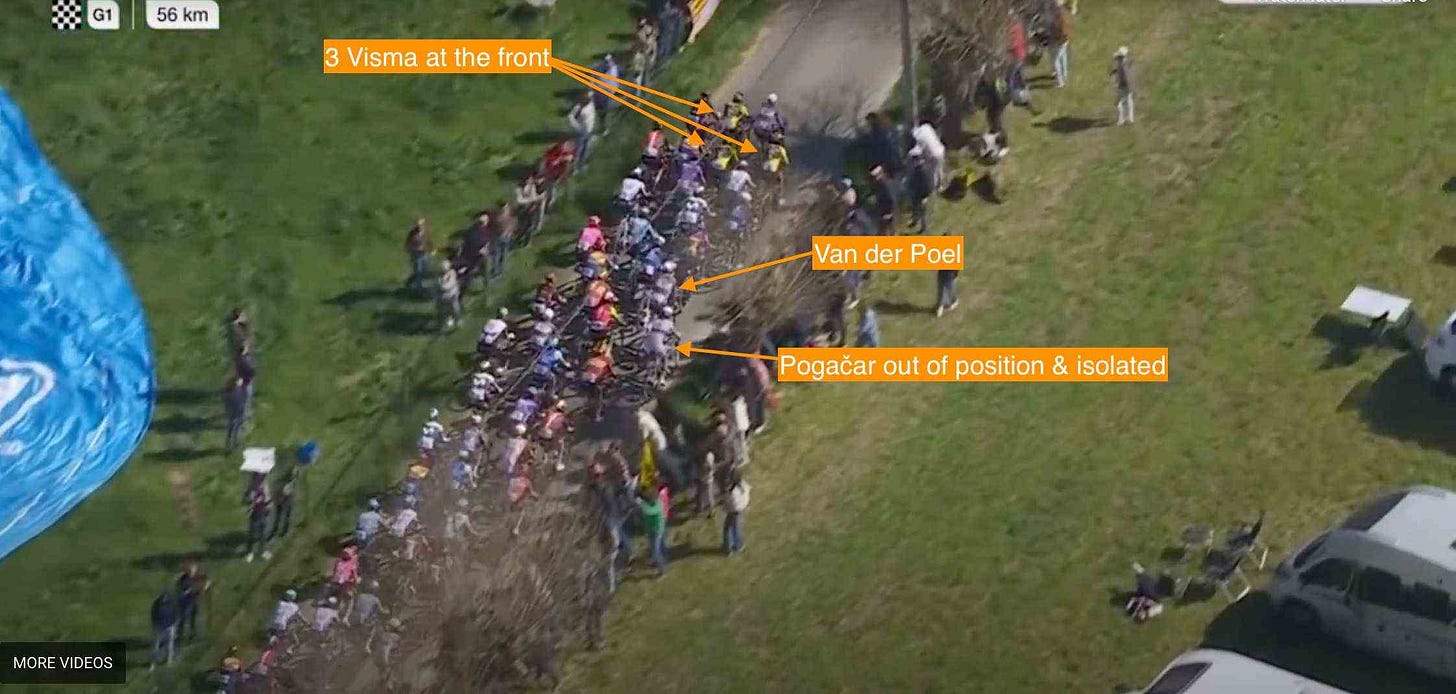
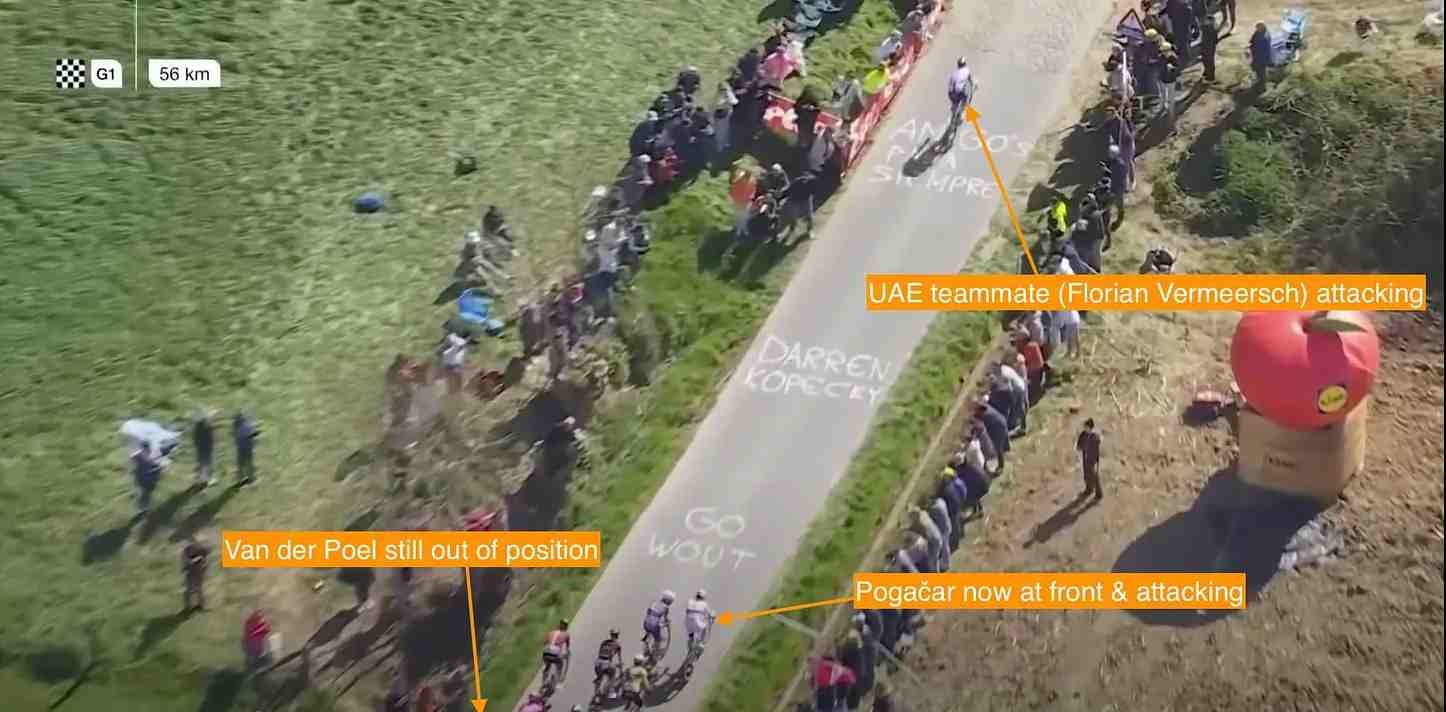



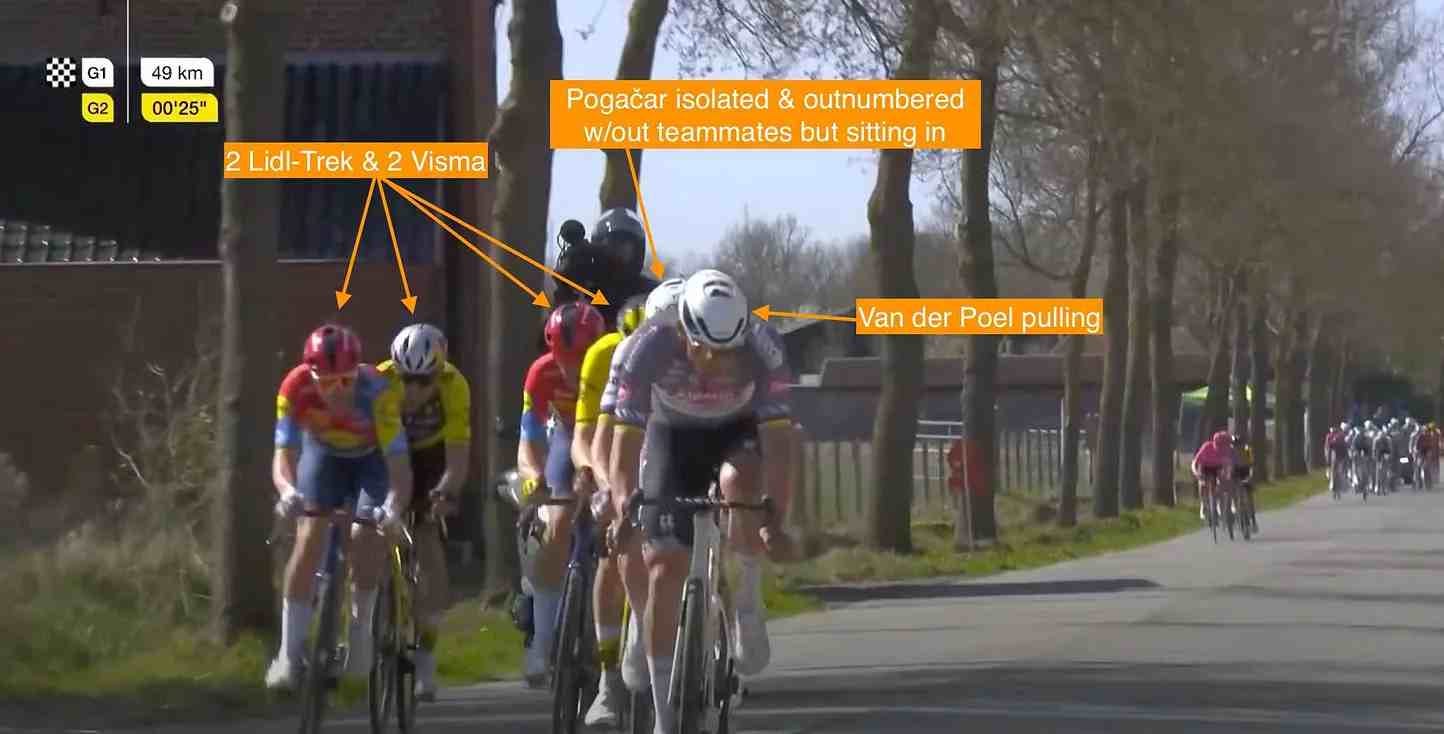

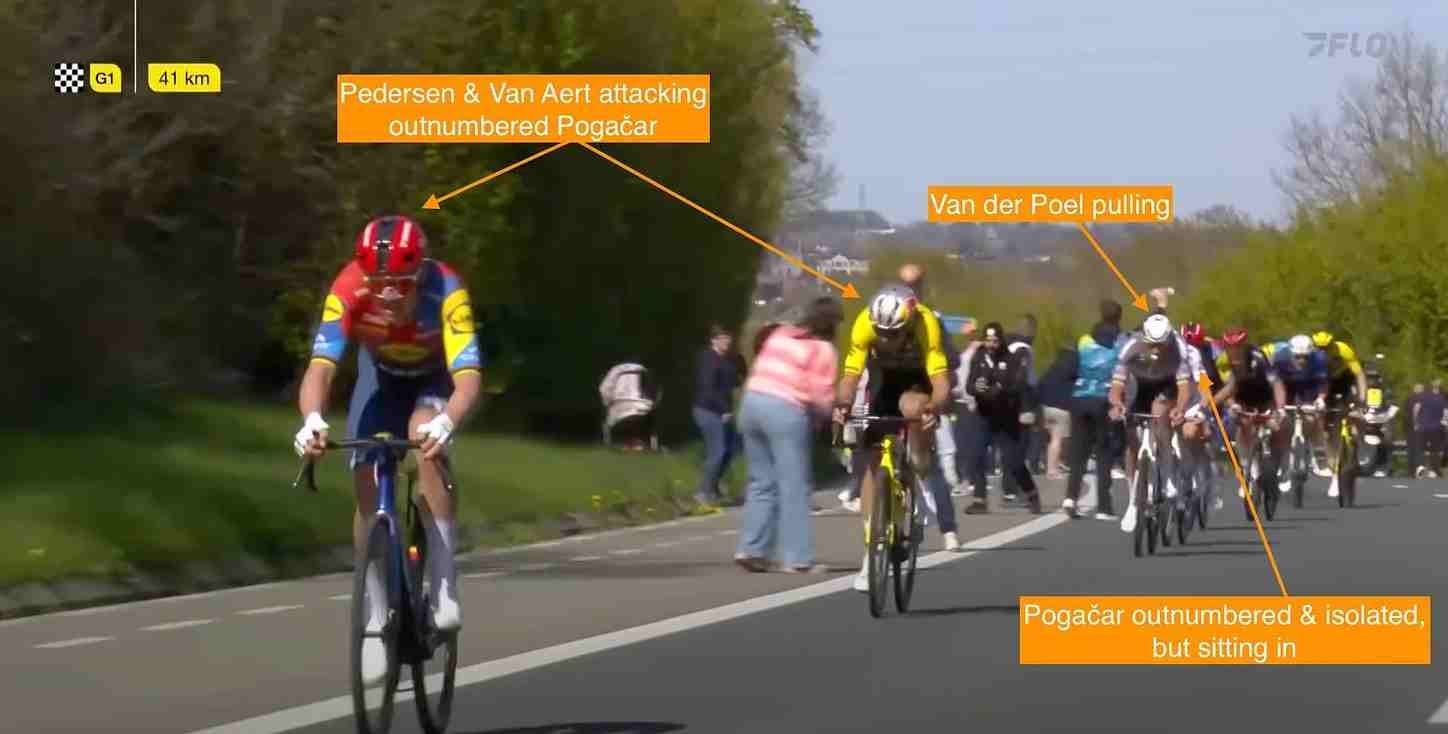
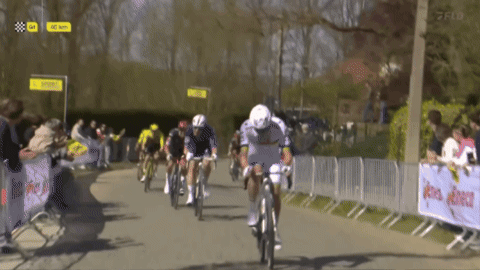
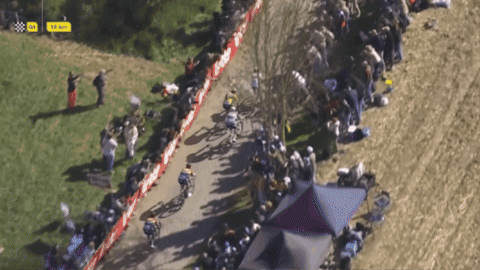


Your analysis is the best available but respectfully, ver der Poel crashed and was reportedly ill and yet finished just one minute behind Tadej. They've raced twice in classics this season and each has won once. I don't get the Pogacar one-day dominance conclusion.